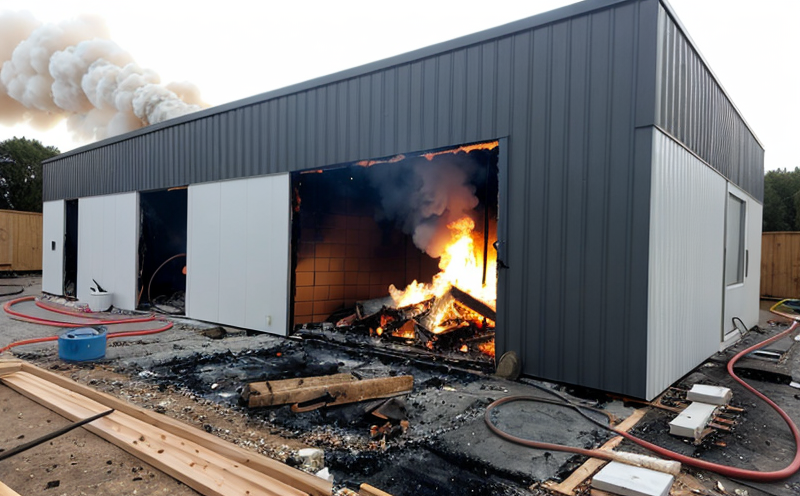Combustibility Testing of Cladding Materials
The combustibility testing of cladding materials is a critical aspect of fire safety testing, especially in the context of building and construction. This service ensures that exterior wall components do not contribute to the spread of fire within a structure, thereby safeguarding lives and property.
Cladding materials are often used on the exteriors of buildings to enhance appearance or provide insulation against heat and sound. However, these materials can also pose significant risks if they burn easily under certain conditions. The combustibility testing evaluates how these cladding materials behave in a fire environment, providing crucial data for compliance with international standards such as ISO 15297:2014 and EN 13826.
The test procedure involves exposing a specimen of the cladding material to controlled conditions that simulate real-world scenarios. This helps determine whether the material will ignite easily, burn vigorously, or remain stable under fire exposure. By understanding these characteristics, architects, engineers, and builders can make informed decisions about selecting materials that are safe for use.
The testing process typically involves the following steps:
- Preparation of a representative specimen from the cladding material
- Exposure to specified fire conditions in a laboratory setting
- Measurement and recording of flame spread, smoke production, and other relevant parameters
- Evaluation against set criteria for combustibility classification
The results of this testing are essential for ensuring compliance with building codes and regulations. They provide valuable insights into the behavior of cladding materials under fire conditions, helping to mitigate potential risks associated with their use.
Scope and Methodology
The scope of combustibility testing in cladding materials is broad and encompasses various aspects of material performance. The primary focus is on evaluating the likelihood that a given material will burn, how quickly it burns, and the amount of heat and smoke generated during combustion.
The methodology used for this testing adheres closely to internationally recognized standards such as ISO 15297:2014 and EN 13826. These standards provide detailed guidelines on specimen preparation, test setup, and data collection.
| Standard | Description |
|---|---|
| ISO 15297:2014 | Fire performance of external cladding and other surface materials for buildings – Determination of the heat release rate, smoke production and flame spread characteristics. |
| EN 13826 | Determination of the resistance to ignition, flame propagation and smoke development in external wall cladding systems. |
The testing process involves several key steps:
- Selection of an appropriate specimen size
- Exposure to a standard fire source
- Measurement and recording of various parameters including heat release rate, smoke production index, and flame spread index
- Evaluation against specified criteria for combustibility classification
Benefits
The benefits of combustibility testing in cladding materials are numerous and far-reaching. Conducting this type of testing offers several advantages that contribute to safer buildings and structures:
- Enhanced Safety: Ensures that cladding materials do not exacerbate fire conditions within a building.
- Compliance with Regulations: Helps ensure compliance with local, national, and international standards for fire safety.
- Improved Reputation: Demonstrates commitment to quality and safety, enhancing the reputation of architects, engineers, and builders.
- Cost Efficiency: Early identification of non-compliant materials can save significant costs associated with rework or replacement.
Use Cases and Application Examples
Combustibility testing is particularly relevant for several use cases across different sectors. Here are some examples:
| Use Case | Description |
|---|---|
| New Construction | Evaluating the safety of new cladding materials before installation. | Retrofitting Existing Buildings | Assessing the need for replacing or modifying existing cladding to meet current standards. |





